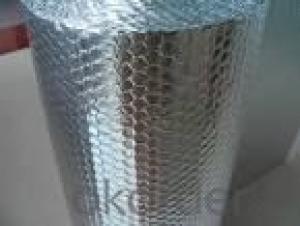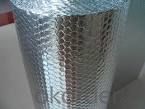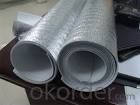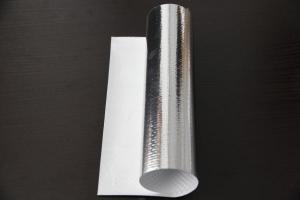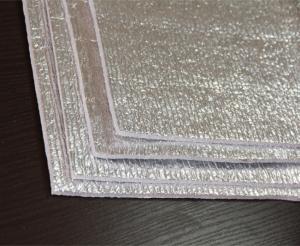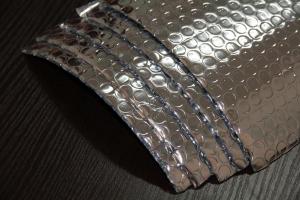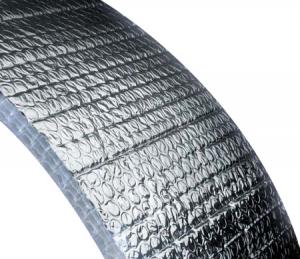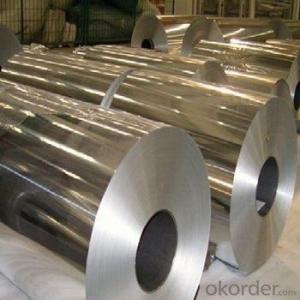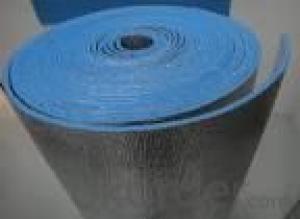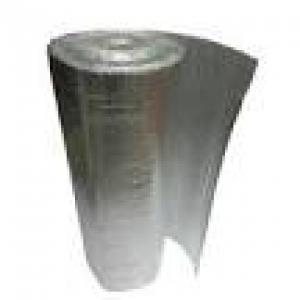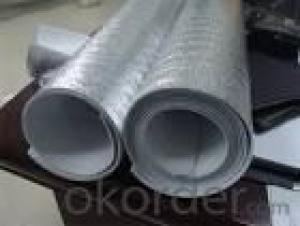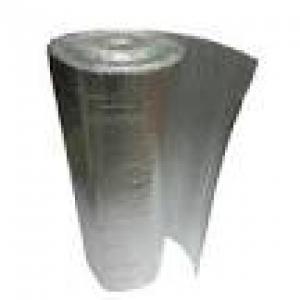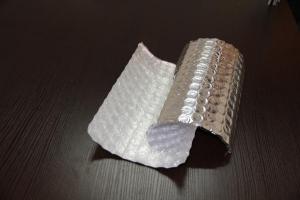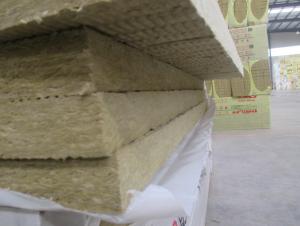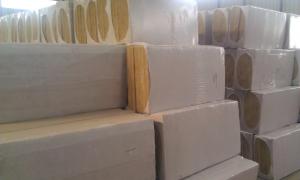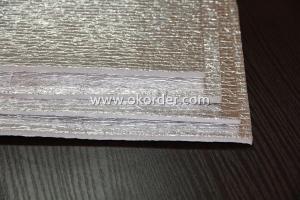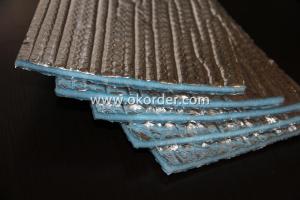Roofing Insulation Philadelphia PA - Aluminum Foil Coated Bubble Insulation Type 20
- Loading Port:
- Shanghai
- Payment Terms:
- TT OR LC
- Min Order Qty:
- 10000 m²
- Supply Capability:
- 100000 m²/month
OKorder Service Pledge
OKorder Financial Service
You Might Also Like
Bubble Insulation Benefits:
Reflects 96% of radiant heat
Non-toxic / Non-carcinogenic
Does not require protective clothing or respirators to install
Durable and lightweight
Does not compress, collapse or disintegrate
Vapor and radon retarder
Easy to cut and install
Permanent and maintenance-free
Does not provide a growth medium or nutritive value for fungus, insects, or rodents
Does not support the growth of mold or mildew
Not affected by moisture or humidity
Lowers heating and cooling costs year round
Bubble Foil Application:
Metal & Steel Buildings
Homes
Roof Underlayments
Cathedral Ceilings
Crawl Spaces
Hot Water Heaters
Basement Walls
Floors
Garage Doors
Concrete slabs
Driveway snow melts
Pole barns
Post frame buildings
Poultry barns
Animal kennels
Temperature sensitive storage areas
Air Bubble Foil Insulation Tech Data:
Material Structure: AL/Bubble/AL | ||
Bubble Size:D10mm*H 4mm(10*2.5/10*4/10*6/20*7/25*10)choose the bubble size | ||
Bubble Weight:0.13kg/m2 ( can be customized ) | ||
Roll Width:1.2m (lenth can be customized) | ||
PROPERTIES | TEST DATA | UNIT |
Thickness | 3.5-4 | mm |
Weight | 250 | g/m2 |
Emissivity | 0.03-0.04 | COEF |
Thermal conductivity | 0.034 | w/m0 |
Apparent Density | 85 | kg/m3 |
Reflectivity | 95-96 | % |
Water Vapour Transmission | 0.013 | g/m2kpa |
Corrosion | doesn't generate | |
Tensile Strength(MD) | 16.98 | Mpa |
Tensile Strength(TD) | 16.5 | Mpa |
- Q: do I have to blow insulation in the roof of my mobile home if I install foam insulation under a meatle roof?
- Some mobiles have a vented attic and some don't. If your attic is vented, the foam on the roof won't help insulate inside the house. I've blown insulation into a mobile home attic before (vented attic), but some mobiles one can't (not vented attic). There are different variations of attic venting, dictating if you can blow in or not. I would add insulation anyway, if you can, mobiles usually skimp on attic insulation, even if they are "certified".
- Q: How do I find roofers who are specialised in protection against invaders from outer space. I called 10 and they said they would call me back, but no one did so far. It must be really complicated.
- Don't fall for this SCAM! Everyone knows that lining your roof with aluminum foil acts as an antenna. Making it easier for those little gray bastards to track your every move. And most roofers are in cahoots with those outer space nar-do-wells This myth/propaganda was originally disseminated by the Inter-Galatic Agency for Human Anal Probing (AgHAP). I first became aware of this little plot after dealing with roofers for many years as a GC. After only a brief conversation with anyone on a roofing crew and you can only assume there are from another plant.
- Q: I know you're not supposed to directly insulate the roof due to the roof getting super heated in the summer, but my walk-in (actually, more like "crawl in") attic is very hot in the summer and very cold in the winter. Is there anything I can do to improve efficiency? I can't help but think I'm wasting a lot of energy just to keep my roof lasting a little longer.
- The reason you do not put insulation directly on the underside of your roof is all about moisture and mold. You need an air gap between the roof and the insulation and allow it to breath. This prevents moisture from condensation that can cause big problems. You could install a radiant barrier that reflects the heat. Do a google search to learn more about it. You could install and attic fan to suck the hot air out in the summer. Most important is to make sure the insulation on the attic floor is the proper thickness.
- Q: Live in Houston, very hot and humid. Looking at adding radiant and additional insulation to roof in house. We have a lot of sun, and AC bills.
- we live in the desert, and got our roof coated, and instantly noticed the difference, it is much more insulated, and provides protection against leak (which was the main reason we had it done)
- Q: Would it be worth forwarding the offer to the client? Is the difference that substantial?
- You don't want that. If he offers 3.5 instead of the required 3, that is a different story. Otherwise he should give you more material thickness to provide an equivalent R of 3. Yes, the difference can be substantial and I wouldn't forward it to the client. The smaller the R value of the entire roof sandwich the larger the difference it makes. Like the change from 5 mpg to 4 mpg is a 25% worsening in fuel economy, but a change from 100 mpg to 99 mpg is 1%. It will mess up the heating/cooling of the building and the mechanical systems might be inadequate. They could save money on the roof and complain how the building is too hot/too cold or the mechanical systems never shut off and their energy bills are too high.
- Q: the name of the company is SIG plc.I need help asap, cos I am struggling to figure it out. If it is not, what kind of competition is it???
- Sure can..........if it's the only store in town...........
- Q: weather stripping/ foam strip?
- Those foam strips they sell you to go under the ridge caps will eventually dry out, blow out, and be hanging all over the place. Caulking won't fill a 5/8's gap to keep the wind/rain out, and tar has no place whatsoever on a metal roof, you'll get it all over everything, and either one will look like ****. The best ridge cap has to be custom made and cut to fit. I use a 12" wide X 10' strip, bent in half to pitch, and then turn down 90 degrees on the edges, whatever the rib height is, usually 5/8". Hold the ridge cap in place on the ridge and mark where the ribs are, then notch out for the ribs so that the cap sits flush over the ribs and down on the flats, punch holes and screw down thru the tops of the ribs. It's a little time consuming but it makes for a good looking finished product that won't wear out.
- Q: attic insulation
- Blow in insulation is so easy and cost effective, do it yourself. Machines can be rented at Lowes, HD, etc where you buy the material.
- Q: What's better- to lay out roof insulation in an old house or to get it blown in?
- anybody can do either.nothing to it.i prefer blown, because it isnt near as itchy.you can rent the blower from home stores, but it takes 2 people to run.
- Q: I've found lots of building forums and general "building advice" columns that go over very high-level pros/cons to choosing roofing material and insulation options, but I want a site where I can see hard costs of ordering each of the materials so I don't have to call up a ton of contractors or dealers. Does such a comparison site exist? Everyone offers quotes, but that takes too much time to apply for quotes to every dealer.I'm specifically interested in knowing what green options I can afford (cotton batting vs. formaldehyde-free fiberglass, etc.).
- It's in euro's but you can convert or get the idea. Also, you have to click on the graphs to get a more clearer image.
Send your message to us
Roofing Insulation Philadelphia PA - Aluminum Foil Coated Bubble Insulation Type 20
- Loading Port:
- Shanghai
- Payment Terms:
- TT OR LC
- Min Order Qty:
- 10000 m²
- Supply Capability:
- 100000 m²/month
OKorder Service Pledge
OKorder Financial Service
Similar products
Hot products
Hot Searches
Related keywords
